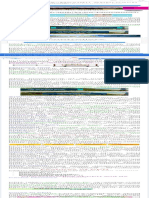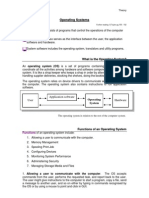How to Start Computer Programming for Class 10 Students
Uploaded by
vikasHow to Start Computer Programming for Class 10 Students
Uploaded by
vikasHow to Start Computer Programming for Class 10 Students
Computer programming is an essential skill in today's technology-driven world. For Class 10 students,
getting started with programming can be both exciting and challenging, but with the right approach,
it can be a rewarding experience. Here’s a step-by-step guide to help students begin their journey
into the world of computer programming.
Step 1: Understand the Basics of Computers and Programming
Before jumping into writing code, it’s important to understand the fundamentals of computers and
how they work:
• What is a Computer?: Learn about hardware, software, and how a computer processes
instructions.
• What is Programming?: Programming involves writing instructions (called code) that a
computer follows to perform tasks.
• Programming Languages: Learn that programming languages (like Python, C++, Java) are
used to write instructions that computers can understand.
Key Concepts:
• Algorithms: A sequence of steps to solve a problem.
• Syntax: The rules that define how code must be written in a particular language.
• Logical Thinking: Programming often requires breaking down problems into smaller,
manageable tasks.
Step 2: Choose a Programming Language
For Class 10 students, the most commonly recommended programming languages are:
1. Python:
o Why Python?: Python is beginner-friendly, widely used in schools, and has a simple
syntax that is easy to learn.
o Applications: Web development, data analysis, automation, and artificial
intelligence.
2. Scratch (optional for younger students):
o Why Scratch?: Scratch is a visual programming language that helps beginners
understand programming logic through drag-and-drop blocks. It’s a great starting
point for younger students before transitioning to text-based languages.
3. C++:
o Why C++?: C++ is a foundational programming language often introduced in later
classes and is good for understanding how computers manage memory.
o Applications: System software, game development, real-time systems.
4. Java:
o Why Java?: Java is object-oriented, widely used in industry, and excellent for building
cross-platform applications.
o Applications: Android app development, enterprise-level applications, web apps.
For Class 10, Python is often the most recommended language due to its simplicity and wide
applicability.
Step 3: Set Up Your Programming Environment
You’ll need a text editor or Integrated Development Environment (IDE) to write and run your code.
• Python:
o Install Python from the official website: Python.org.
o You can use IDLE (Python’s built-in editor) or install a popular IDE like PyCharm or
VSCode for better features.
• Scratch:
o You can use the online editor at Scratch.mit.edu without needing to install anything.
• C++ or Java:
o Use IDEs like Code::Blocks (C++) or Eclipse and NetBeans (Java).
Step 4: Start with Simple Programs
Once your environment is set up, start by writing simple programs to get familiar with the syntax.
Python Example:
# Program to print "Hello, World!"
print("Hello, World!")
This is the simplest program in any language, and it's a great first step.
Scratch Example:
• Create a simple project where a character (sprite) says "Hello, World!" when clicked.
Step 5: Learn Basic Programming Concepts
These are the fundamental concepts you’ll need to understand when programming:
1. Variables:
o Variables store data like numbers, text, or more complex data structures.
o Example in Python: age = 15
2. Data Types:
o Different types of data: integers (numbers), strings (text), floats (decimal numbers),
booleans (True/False).
3. Input and Output:
o Input: Gathering information from the user (e.g., input() in Python).
o Output: Displaying information to the user (e.g., print() in Python).
4. Conditional Statements:
o Use if, elif, and else to make decisions in your code.
o Example:
o age = int(input("Enter your age: "))
o if age >= 18:
o print("You are an adult.")
o else:
o print("You are a minor.")
5. Loops:
o For Loop: Repeat a block of code a fixed number of times.
o for i in range(5):
o print(i)
o While Loop: Repeat a block of code as long as a condition is true.
o count = 0
o while count < 5:
o print(count)
o count += 1
6. Functions:
o A function is a block of code that only runs when it is called.
o Example:
o def greet(name):
o print("Hello, " + name)
o greet("Alice")
Step 6: Practice with Small Projects
After learning the basics, practice by working on simple projects that interest you. Here are some
ideas for beginner-level projects:
• Calculator: A basic calculator that can add, subtract, multiply, and divide.
• Number Guessing Game: The computer generates a random number, and the player guesses
the number.
• To-Do List: A simple program to add, view, and delete tasks from a to-do list.
Step 7: Explore Problem Solving with Algorithms
Programming is not just about writing code; it’s also about problem-solving. Start practicing
algorithms, which are step-by-step instructions for solving problems:
• Sorting Algorithms: Learn how to arrange numbers in ascending or descending order (e.g.,
Bubble Sort, Selection Sort).
• Searching Algorithms: Learn how to find a specific item in a list (e.g., Linear Search, Binary
Search).
There are many free online resources, such as GeeksforGeeks, to understand basic algorithms.
Step 8: Learn from Online Resources and Books
Several resources can help you improve your programming skills:
• Books:
o "Python Crash Course" by Eric Matthes (for Python beginners).
o "Head First Java" by Kathy Sierra (for Java beginners).
• Online Courses:
o Coursera: Offers beginner-friendly programming courses.
o Udemy: Find many affordable beginner courses in Python, Java, and C++.
o edX: Offers free introductory courses from universities like Harvard and MIT.
• Practice Platforms:
o Codewars: Offers programming challenges to improve your coding skills.
o HackerRank: Provides problems and contests to practice coding.
Step 9: Join a Coding Community
Connecting with other students and developers can be very helpful in your learning journey. You can
join coding forums, participate in coding challenges, and ask questions.
• Stack Overflow: A question-and-answer site for programmers.
• GitHub: Host your projects and contribute to open-source projects.
• Reddit: Subreddits like r/learnprogramming can be great for beginners.
Step 10: Keep Practicing and Stay Curious
Programming is a skill that improves with consistent practice. Try solving problems daily, building
projects, and exploring more complex topics like object-oriented programming, databases, and web
development.
• Challenge yourself: Work on harder problems as you improve.
• Learn new concepts: Explore more advanced topics like data structures (arrays, linked lists)
and algorithms (sorting, searching).
Conclusion
Starting to learn programming at the Class 10 level is a great decision and an exciting journey. By
following these steps and practicing regularly, you’ll gradually become proficient in coding.
Remember that programming is all about problem-solving, so the more you practice, the better you'll
get!
You might also like
- Introduction to Computer Programming for Class 10No ratings yetIntroduction to Computer Programming for Class 103 pages
- References to Start Computer Programming for Class 10 StudentsNo ratings yetReferences to Start Computer Programming for Class 10 Students5 pages
- Learning to Code is a Valuable and Exciting Journey That Can Open…No ratings yetLearning to Code is a Valuable and Exciting Journey That Can Open…3 pages
- CSE101 Lecture Notes for Mid Term ExamsNo ratings yetCSE101 Lecture Notes for Mid Term Exams106 pages
- Self Programming Book For Beginner @DatascienceMNo ratings yetSelf Programming Book For Beginner @DatascienceM391 pages
- Python for Everyone: A Complete Guide to Coding, Data, and Web Development: Your Guide to the Digital World, #3From EverandPython for Everyone: A Complete Guide to Coding, Data, and Web Development: Your Guide to the Digital World, #3No ratings yet
- Welcome To Computer Programming: IntroductionNo ratings yetWelcome To Computer Programming: Introduction66 pages
- Computer Programming Fundamentals (2024)No ratings yetComputer Programming Fundamentals (2024)486 pages
- Coding With Python for Kids Learn How to Use the Most Popular Programming Language in Just 3 Days Developing Simple Software on Your Own From Scratch in a Simple and Fun Way by Frank Nolte [Nolte, Fra (z-lib.org).ep100% (2)Coding With Python for Kids Learn How to Use the Most Popular Programming Language in Just 3 Days Developing Simple Software on Your Own From Scratch in a Simple and Fun Way by Frank Nolte [Nolte, Fra (z-lib.org).ep109 pages
- The Complete Coding Manual Vol. 31 2019No ratings yetThe Complete Coding Manual Vol. 31 2019163 pages
- 1. an Overview of Computers and Programming LanguagesNo ratings yet1. an Overview of Computers and Programming Languages10 pages
- Python for Everyone 2nd Edition Cay Horstmann 2024 Scribd Download100% (2)Python for Everyone 2nd Edition Cay Horstmann 2024 Scribd Download89 pages
- 9 BP - WEEK 1 - Recognize The Significance of Computer Programming - Noemi F MagnoNo ratings yet9 BP - WEEK 1 - Recognize The Significance of Computer Programming - Noemi F Magno7 pages
- Complete Download (Ebook) Python for Everyone by Cay Horstmann, Rance Necaise ISBN 9781119056553, 1119056551 PDF All Chapters100% (3)Complete Download (Ebook) Python for Everyone by Cay Horstmann, Rance Necaise ISBN 9781119056553, 1119056551 PDF All Chapters71 pages
- Black Dog Media - The Complete Coding Manual - 3 Ed.No ratings yetBlack Dog Media - The Complete Coding Manual - 3 Ed.23 pages
- How To Start Coding - The Ultimate Guide For Beginner ProgrammersNo ratings yetHow To Start Coding - The Ultimate Guide For Beginner Programmers22 pages
- The Complete Python Coding Manual - 3rd Edition, 2023No ratings yetThe Complete Python Coding Manual - 3rd Edition, 2023196 pages
- Introductory Lecture on Programming FundamentalsNo ratings yetIntroductory Lecture on Programming Fundamentals5 pages
- SCHOOL OF ENGINEERING TECHNOLOGY Computer Electrical Engineering100% (1)SCHOOL OF ENGINEERING TECHNOLOGY Computer Electrical Engineering30 pages
- Smart Glove For Hearing-Impaired: Abhilasha C Chougule, Sanjeev S Sannakki, Vijay S RajpurohitNo ratings yetSmart Glove For Hearing-Impaired: Abhilasha C Chougule, Sanjeev S Sannakki, Vijay S Rajpurohit5 pages
- HCIA-Data Center V1.5 Training Materials PDF100% (3)HCIA-Data Center V1.5 Training Materials PDF980 pages
- Characteristics of Computer System: SpeedNo ratings yetCharacteristics of Computer System: Speed4 pages
- What Is CPU and Its Components Parts of CPU and Their Functions!!No ratings yetWhat Is CPU and Its Components Parts of CPU and Their Functions!!1 page
- What Is A Sample Objective Statement For A ProgrammerNo ratings yetWhat Is A Sample Objective Statement For A Programmer103 pages
- Ulangan Akhir Semester Ganjil Sekolah Menengah Pertama 79 Jakarta TAHUN PELAJARAN 2014/2015 Lembar SoalNo ratings yetUlangan Akhir Semester Ganjil Sekolah Menengah Pertama 79 Jakarta TAHUN PELAJARAN 2014/2015 Lembar Soal4 pages
- Transcultural Nursing Assessment and Intervention Giger 6th Edition Test Bankinstant download100% (9)Transcultural Nursing Assessment and Intervention Giger 6th Edition Test Bankinstant download30 pages
- Introduction To ICT Comp 201.: Click To Add TextNo ratings yetIntroduction To ICT Comp 201.: Click To Add Text57 pages

























































































